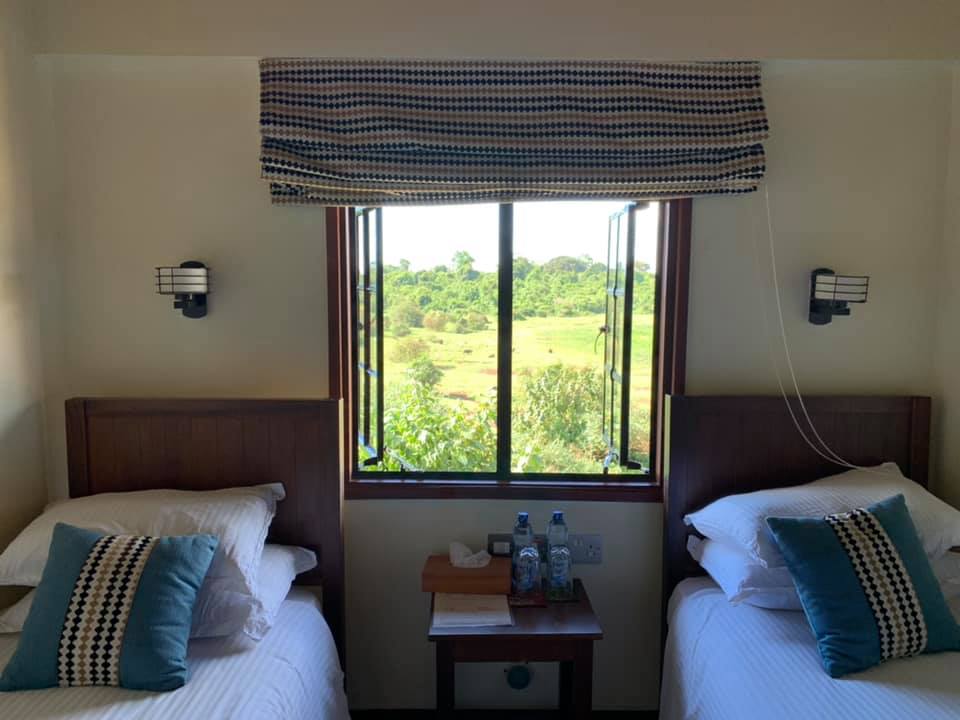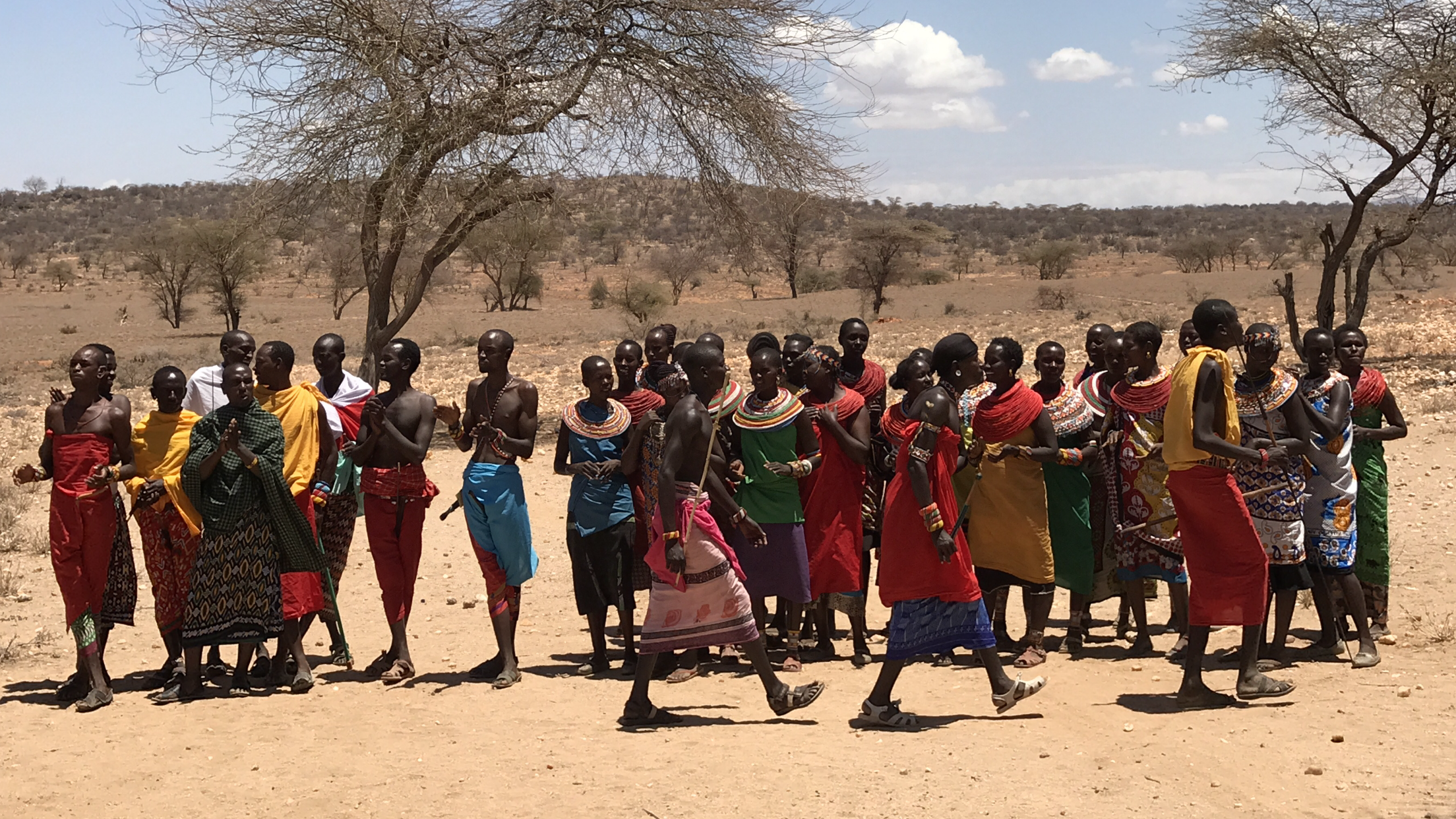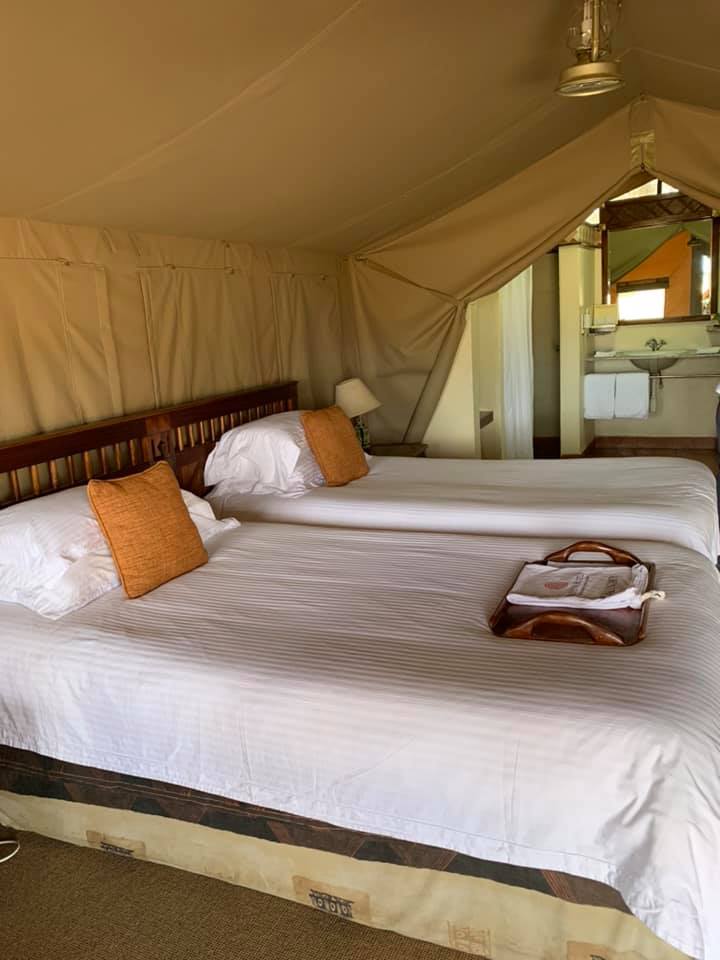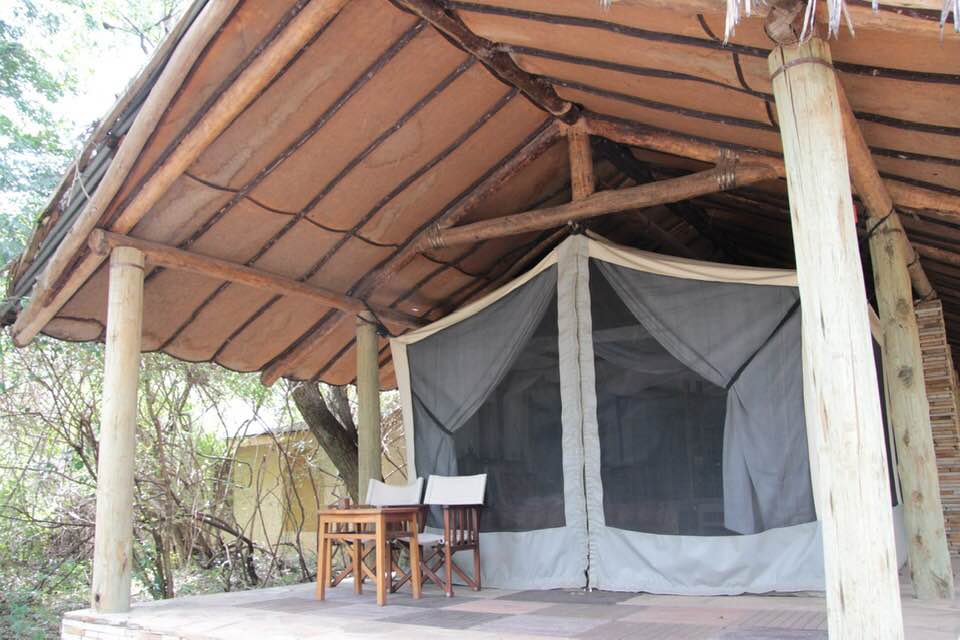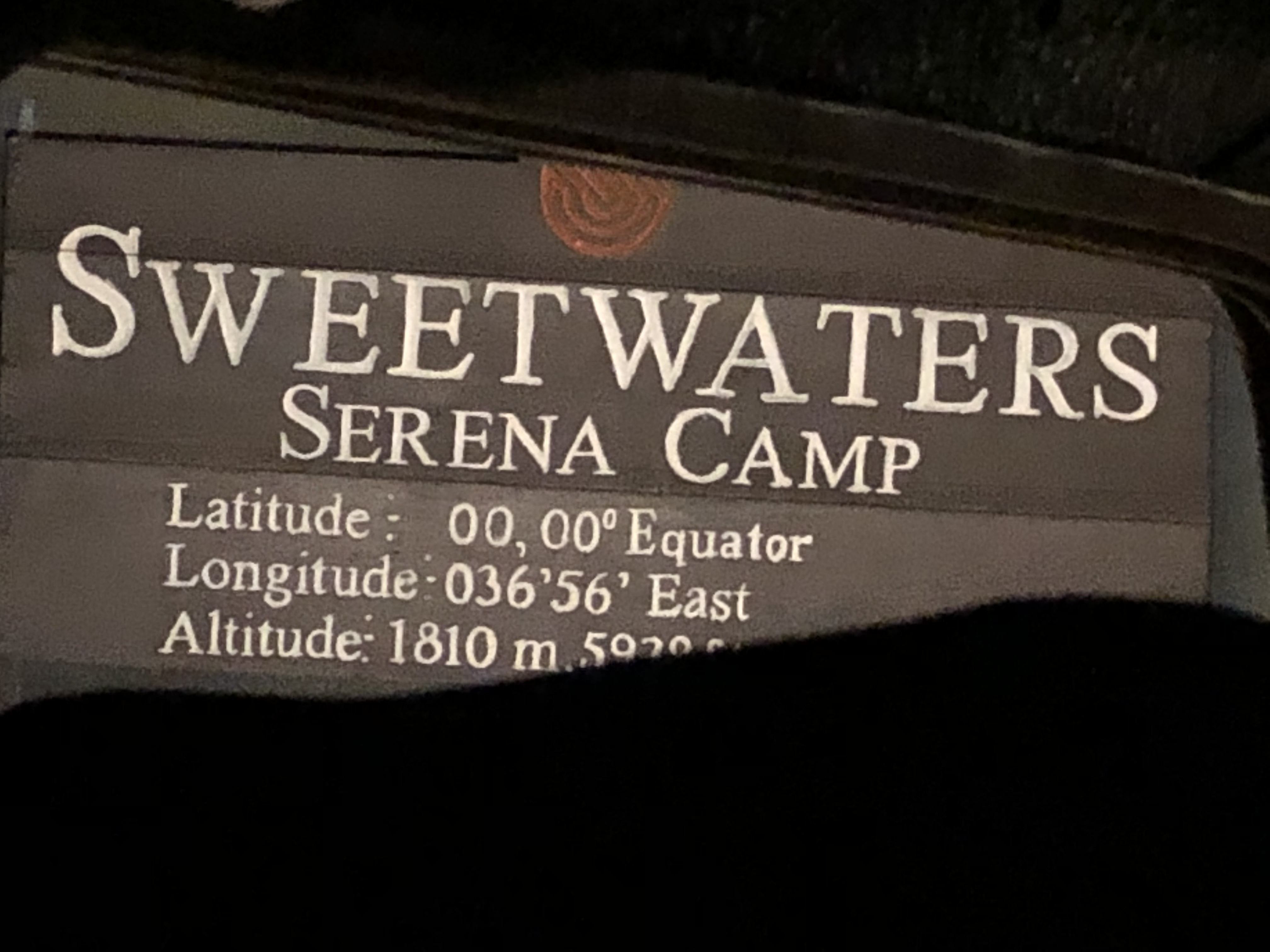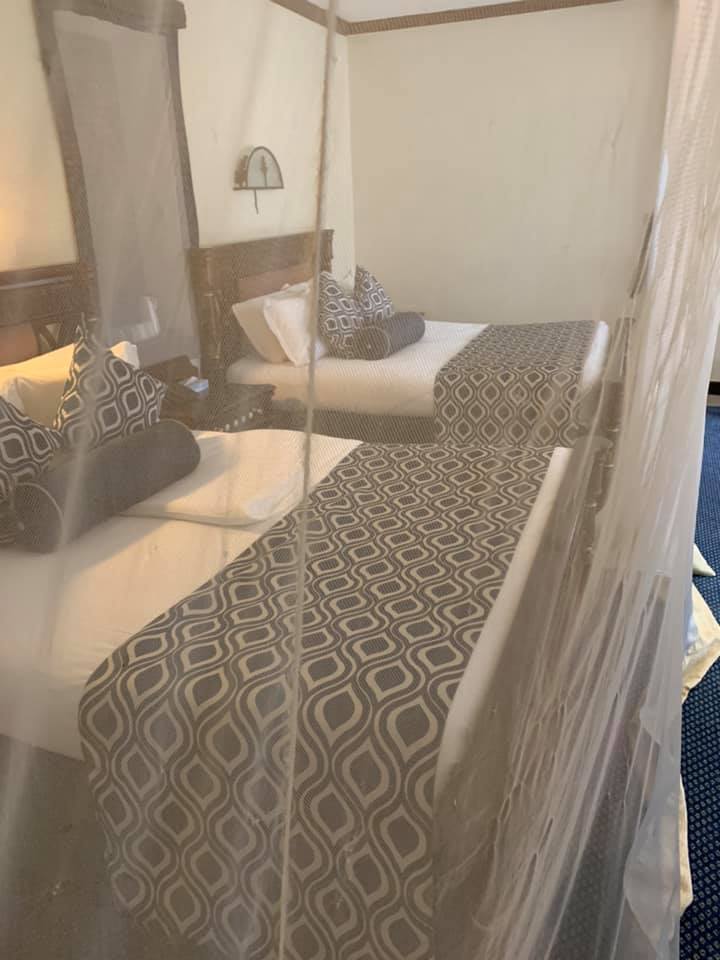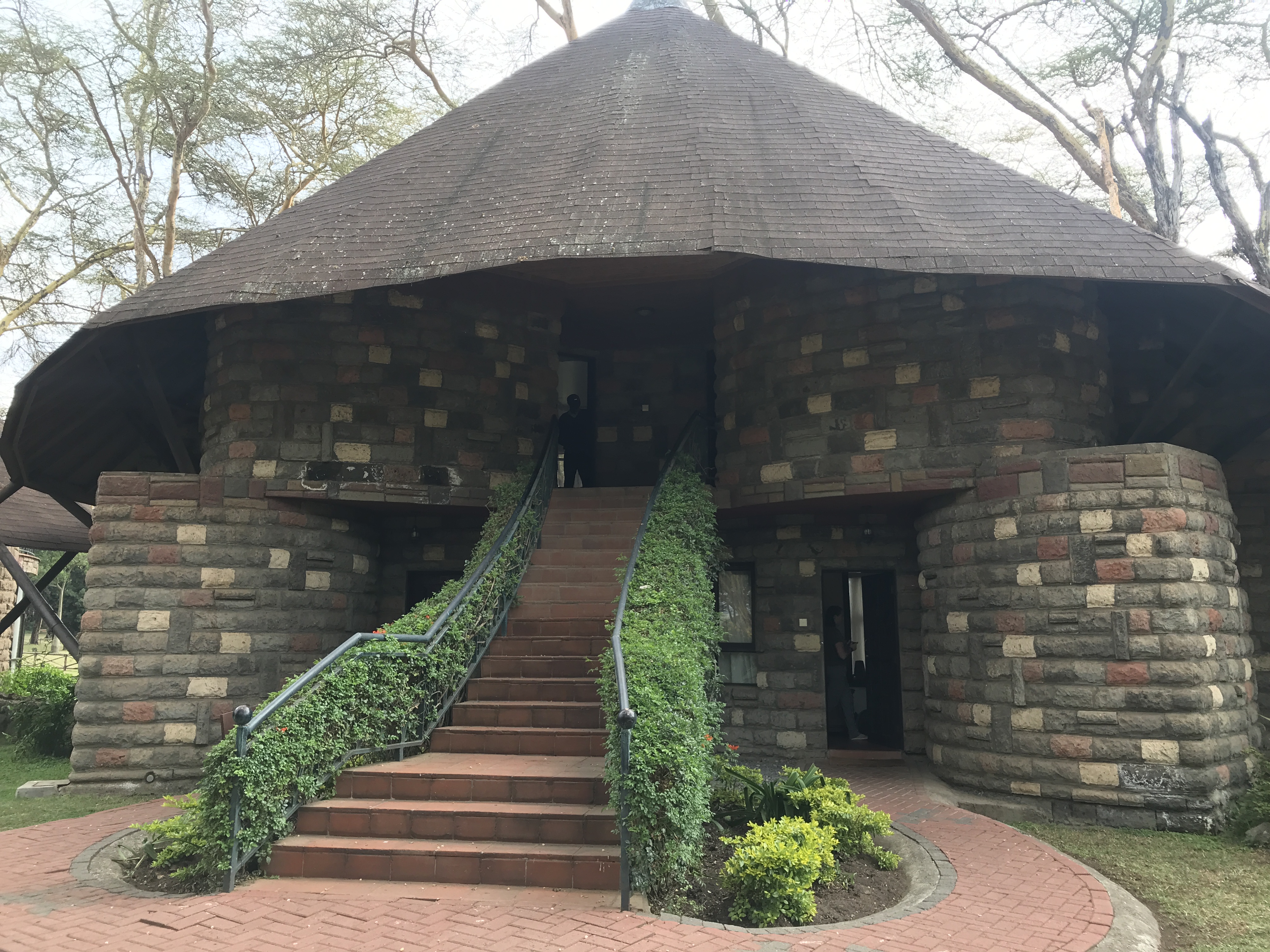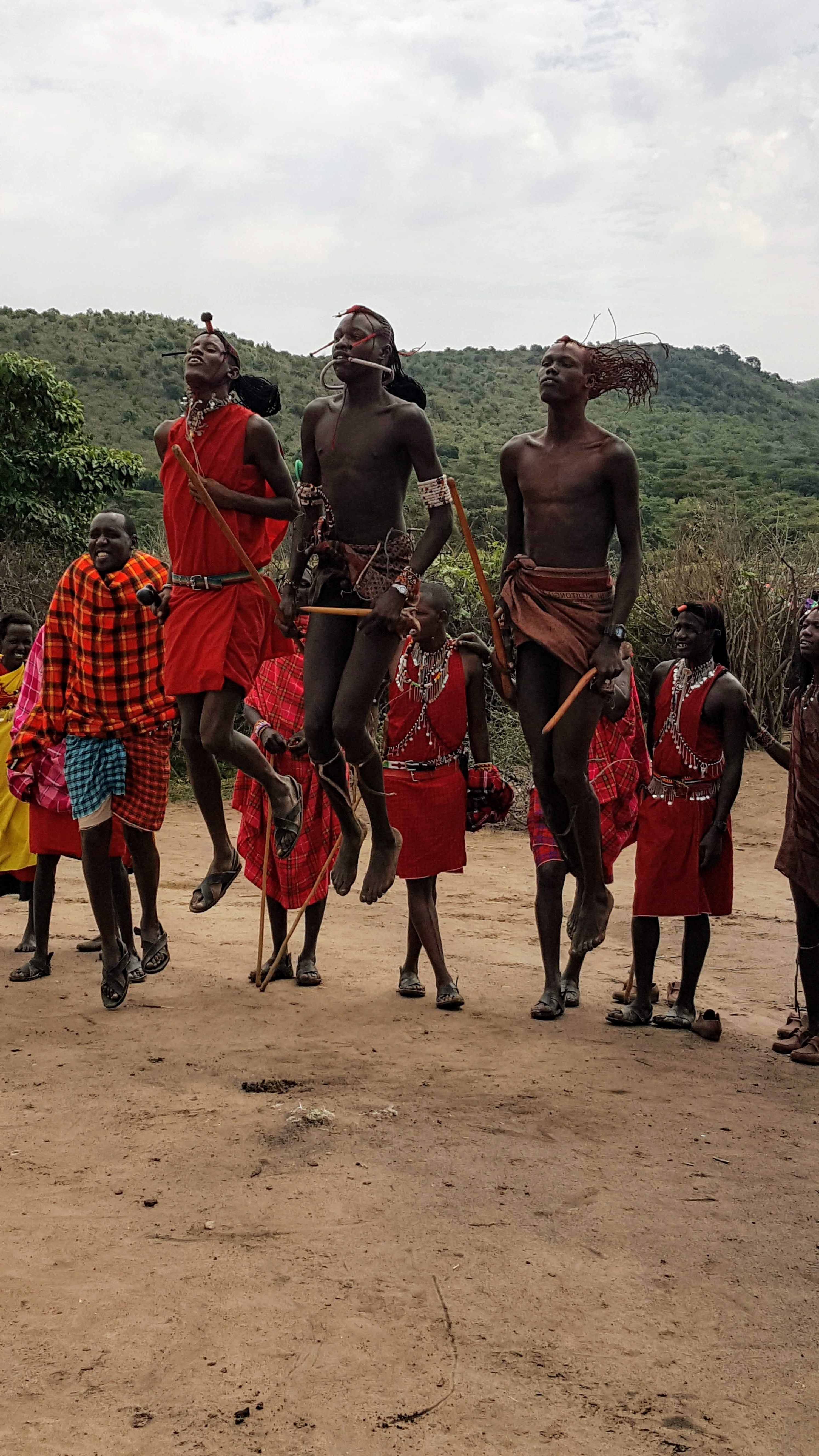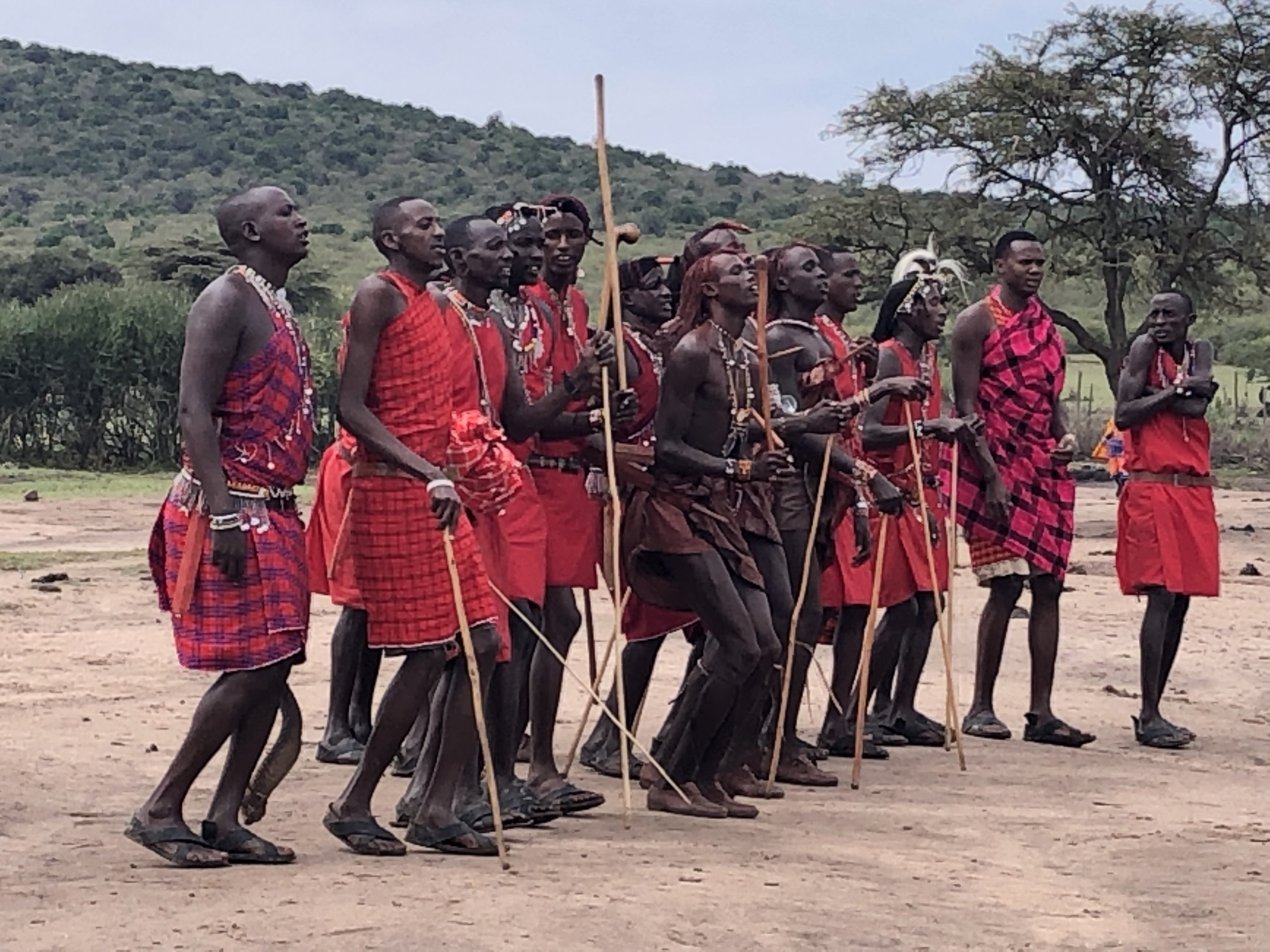Welcome to Kenya
Part 3: The Cuisine and the Lodging
Table of Contents
- Overall Favorite Lodgings
- Nairobi
- Aberdares County
- Samburu
- Ol Pejeta
- Lake Naivasha
- Maasai Mara
- Conclusion
Overall Favorite Lodgings
In Kenya, we stayed at several resorts at different locations around the Equator and in southern Kenya. Let’s walk through each one, highlight the benefits of each of them, show some pictures, and talk about the buffet meals! Yum! 🍝🥩🥙🍇🥖🍷🥮
Best food: Sarova Shaba Game Lodge or Tamarind Tree Hotel
Cleanest overall resort/hotel: Tamarind Tree Hotel
Cleanest room/suite: Tamarind Tree Hotel
Coziest beds: Sweetwaters Serena Camp
Most impressive resort grounds: Sarova Shaba Game Lodge
Highest probability of seeing animals on the resort: Sarova Shaba Game Lodge or Sopa Resort
Best overall location in the country to see animals: Fig Tree Camp
Nairobi ☞ Tamarind Tree Hotel
Tamarind Tree Hotel was by far the nicest place we stayed at in Nairobi. It was colorful 🌈, clean 🧼, the food was delicious, and the staff was pleasant. The entire hotel felt very safe, as there were security measures everywhere.
When we arrived, there was a gate at the entrance with guards. After letting our trucks in, we were surprised to find there was a metal detector at the main entrance, which everybody had to go through before entering the actual hotel. Even all of our bags had to be scanned by an x-ray machine (like TSA at the airport).
To take an elevator to any floor (besides the ground floor), you needed to have a keycard for that specific floor. I appreciated the extra feeling of security, even if it was somewhat irritating when you wanted to visit another room on a different floor.
The shower was interesting—it was just a glass door (which you could see the showerer’s head through), and the tile floor was the same as the tiles in the rest of the bathroom. By the way, the bathroom didn’t even have a door! So it felt very exposed. It was fine when I was sharing a room with somebody I knew well, but it would’ve been more awkward if I was rooming with someone I had just met.
The beds were small (twin sized), but comfortable, especially since we had just come off of a long flight 🛩.
The food was delicious. However, the buffet meal (we were all on our own for dinner) cost around $30, or 3,000 KSH. Therefore, I ended up ordering some spaghetti and bruschetta (and my partner ordered some steak or something) from the normal menu. But, when I asked how the buffet was, everybody said it was delicious and worth the $30 to them. To each their own 🤷🏻♀️.
Unfortunately, my group didn’t get any pictures of Tamarind Tree Hotel, but you can check out their website online (linked above).
Aberdares County ☞ The Ark
The Ark was certainly the most unique place we stayed. The entire hotel/resort was designed to be like Noah’s Ark, where the building is shaped like a boat. At the front (bow), there’s four decks, and each one has an amazing view of a watering hole. A couple of the decks are actually outside, and this provides an amazing experience of the animals without glass—but be very quiet, or else the animals will get scared 🙀!
During the day, the watering hole and surrounding area has hyenas, buffalo, and warthogs. At night, the elephants come out, and stay for hours eating the nutrients (that are meticulously placed) in the dirt, and playing.
The rooms are small, but that’s by design. They feel cozy and snug. The hallways are a maze, but you only need to know how to get to a few places: your room, the entrance/exit, the decks, and the restaurant (but you can get to the food from the decks).
The air was a bit chilly at night (because of the higher altitude in the mountains), but the staff brought warm hot water packs to each bed at night, so our tootsies stayed nice and cozy.
Like Tamarind Tree Hotel, the food here was scrumptious. The breakfast had a made-to-order omelet bar, fresh juice, potatoes, eggs, fruit, rolls, and everything in between. Yum yum yum!
Read more about The Ark ⛵️, and check out their fabulous photo gallery, at their website.
Samburu ☞ Sarova Shaba Game Lodge
The first thing we noticed about Sarova Shaba Game Lodge was that it was beautiful. The grounds were spectacular. There were man-made ponds with coi fish, man-made rivers to make us feel like we were out in nature, baboons and monkeys, large turtles in the rivers, crocodiles with a special crocodile watch area, a pool, gym, and plenty of space to relax at the resort. It was bright and open.
The suites themselves were arranged in little buildings with four suites in each building—two on the ground floor and two on top. The staff warned us to always bolt the doors because there was no latch, and so if they weren’t bolted, then little primates could push their way inside the door and steal food or shiny things. One of my friends even forgot to bolt the door, and had a run-in with a baboon that decided to join them inside! My friends’ roommate managed to scare the baboon off by flicking a whip at it, but we’re still not exactly sure what he wanted inside that room.
The food was incredible. From our first buffet meal, it was clear that their food was superior. They had pasta at every meal, rice, vegetables, bread, meat, and an entire section of desserts. I’m not a huge dessert person myself, so I didn’t really try any, but everyone else I traveled with enjoyed the dessert bar immensely.
They provided an array of extra activities we could do. Our tour guide set up a happy-hour for us that was hosted by the resort. We all went “into the bush,” and they provided live Kenyan music, a guest from a Samburan tribe to talk to us about his village and his life, wine, cocktails, and appetizers. They had a cook who was also very good at photography, and he took several of us down to a river nearby to take some pictures of the setting sun.
I don’t have many pictures of the exterior of Sarova Shaba Game Lodge, and that’s really a pity; the best thing about this resort was the beautiful resort grounds. But, the good news is that their website has plenty of pictures featuring the resort grounds. Here’s one picture of our room and one of the buffet line:
The Samburu Village Visit
Unrelated to the lodging and food, we also took the time to visit a native Samburu village. We learned many things about the native tribes of Samburu. If I recall correctly, there are around 42 Kenyan tribes still in existance, and the Samburu people are one of them. They live in several villages.
The boys become warriors around age 15, after a circumcision ceremony. Then, around 25-30, they’ll become junior elders. It is around this age they can marry. A warrior can marry any amount of women (who are at least 18), but the number they marry is dependent on the livestock they have (warriors determine their wealth and power based on their livestock). Each woman will have their own hut, where they’ll raise their children. The husband chooses which wife’s hut they’ll stay in each night, and that wife is responsible for feeding the husband for the night. Around age 40, then a junior elder becomes an elder.
Children do attend school… now. In school, young children will learn Swahili and English (the two official languages of Kenya), and they’ll potentially learn more languages that are tribe-specific.
Women and mothers take care of the children, take care of the livestock, do beading and art projects, and sell their crafts to visitors and other tribes. We even got the chance to purchase some of their handmade jewelry and crafts.
Ol Pejeta ☞ Sweetwaters Serena Camp
Ol Pejeta’s Sweetwaters Serena Camp was my favorite place we stayed. It’s a tented camp, which means each suite is a full tent. However, it’s not the types of tents that you’d think of when it comes to camping. These tents are on solid tile/wood/brick bases, have solid roofs, and have full bathrooms inside of them, including a toilet, shower, and sink. The tents were clean and well-kept. Take a look at the inside of one of the tents!
The walk from the main resort buildings to the tents was also quite relaxing and beautiful. We even saw a strange bird land on the resort, as well as a couple of small gazelles.
All of the resorts had very similar type of food, but one super cool thing that Sweetwaters Serena Camp did was they had a made-to-order pasta bar at lunch and dinner. They provided several options of types of pastas, several types of sauces, and then each person could select their own vegetables to mix with the pasta. It was very yummy 🍝!
Sweetwaters Serena Camp is on the Equator. No joke, the sign at the entrance gave the latitude and longitude—latitude was 00.00:
So, walking around in direct sunlight was a bit hot. However, as the night came, the air cooled off to a chilly 55°F. However, it wasn’t too cold for my Minnesota tendencies, and I was just fine without a jacket.
That is… until we went for the night game drive. One of the add-ons that I chose to do was night game drive that the resort provided. Read more about that excursion in my blog post The Game Drives. I did get a bit chilly on that adventure, with the chilly, blowing wind (my fault… I had a jacket in the tent and just didn’t bring it with me on the game drive).
The other amazing thing about Sweetwaters Serena Camp is the view. Most of our tents were right along a super long fence, and on the other side of the fence was a watering hole with lots of animals. From the entrance to our tent, it just felt like we could see so far on the horizon, and we could see so many buffalos and elephants. It was truly beautiful and extremely peaceful. Feel free to check out more about Sweetwaters Serena Camp at their website ☝🏼, and take a look at some of their rad pictures in the gallery.
Lake Naivasha ☞ Sopa Resort
Our afternoon in Lake Naivasha was designed to be relaxing. Although we did go on a hippopotamus-viewing boat ride, once we actually got to the resort, we just hung out for the rest of the afternoon.
The Sopa Resort, where we stayed, featured a (very) long walk from the main resort to the cabins, and we took that opportunity to get some exercise. To provide a little bit of context, there were four suites per cabin structure (two on the ground floor, and two on the top floor), and there were 82 suites. However, the entire walk was delightful! It was completely paved, and each cabin looked exactly like the one next to it, which made them seem very cookie-cutter… I actually liked that. It probably helped that my partner and I actually stayed in suite #2, so we never needed to walk a long distance.
The only truly awesome thing about the cuisine at Sopa Resort (that made it stand out), was that it was my birthday the night we stayed there. Our trip leader must’ve mentioned that it was my birthday to the staff, because they brought out a cake for me, and all of the staff did a “congo” line and they sang a native Kenyan song (which featured the words “hakuna matata”) to celebrate my birthday. The chocolate cake was really good, too.
One famous thing about the Sopa Resort is that they’re known for having hippopotamuses out grazing during the night. During the day, hippos lay in and around water to keep cool. But at night, they come out and graze on grass. Although there is a fence between the cabins and the “wild,” the hippos step right over the fence to get more grass! Rumor has it that just last year, a tourist died because he tried to go up to a hippo to get a picture. So, Sopa Resort was our first experience where we had to be “escorted” back to our cabins at night.
Essentially, any time between when the sun sets and 7am the next morning, the resort recommends visitors be escorted back to their cabiins. This is for the visitors’ safety; if the visitors come across a hippo or other animals, then the security guards can take care of the visitors and potentially try to scare away the animals. Except hippos… you just back up slowly and carefully and wait for the hippo to leave (they’re dangerous). At first, this wasn’t so bad, until we realized that whenever you receive an escort, you need to tip the security guard… hence one of the reasons why we spent so much on tips on this trip 💵.
However, if you’re lucky, your cabin windows (or deck on a top floor), gives you a beautiful chance to see some hippos out of the water. My partner and I stayed up trying to look for the hippos, and we even got up periodically in the middle of the night just to look out the windows to see if we could see anything. But we weren’t so lucky. It was nice that our suite provided us a little couch to sit on while we gazed out the windows though:
Feel free to check out even more pictures from Sopa Resort’s gallery on their website!
Maasai Mara ☞ Fig Tree Camp
Fig Tree Camp in the Maasai Mara was the last place we stayed. Fig Tree Camp is another tented camp, and unfortunately we weren’t able to get a picture of our tents at this location. However, the fascinating thing about this resort was that the paths to get from one were lined with bones. I’m sure that locals just pick up random bones they find out on the savanna and bring them back to the resort. They had buffalo skulls, spines, an elephant skull, and more!
But if I’m completely honest, the thing I’ll remember most about Fig Tree Camp was the walk from the main resort shelter to our tent. We were at tent 47. Our tent was so far away that the first employee we asked to escort us to the tent didn’t know where it was—he needed to ask another employee. Our tent was so far away that the stone-paved path eventually disappeared and became a dirt path. Our tent was so far away that we could visibly tell there were less lights indicating our path as we went on. Our tent was so far away, that we got lost trying to find it—twice. And we were following signs! Sometimes, I felt like that walk was a mile long.
However, one cool thing was that all of the tents were almost completely surrounded by a long, curving river. In this river, hippos and crocodiles hang out. Twice we decided to tip a security guard extra to take us to the other side of the tents to try to view the hippos. We did indeed see about five hippos (including babies), and at least one crocodile sitting on the side of the river. They did make a few noises, but my partner and I didn’t stick around long enough to hear a lot of them. But other travelers in our group claimed that the hippo song came on at about 5am each morning (promptly waking up all nearby tents). They also told us that security guards were pacing around the tents all night, listening for any strange noises or any indication that a primate may have gotten into a tent. So maybe our tent was far away, but at least we got a good night’s rest 🤷🏻♀️.
Like some of the other resorts, Fig Tree Camp also offered a special excursion: a sunrise hot air balloon ride over the bush. Of course my partner and I did it! It was our first hot air balloon ride, too. We woke up at the crack of dawn (actually more like 5:30am), and made our way to the center of the resort at 6:30am. After the balloon ride completed (yes, we did see animals playing, walking, and relaxing), we finished the morning with a buffet breakfast, champagne, and mimosas on the bush (provided by the resort).
Oh, the last thing I’ll mention about Fig Tree Camp: they had limited times the power and hot water was on. The power was on in the morning and afternoon/evening, and the hot water ran in the morning (from maybe 6am-9am), and in the evening (approximately 6pm-9pm). I know because the morning of the hot air balloon ride, I took an ice-cold shower.
The Maasai Village Visit
On our last day before heading home, we got the opportunity to visit one more Kenyan tribe: the Maasai tribe. To me, the two tribes look very similar, although I’m sure they would beg to differ. I will say that they don’t wear the same types of clothes, and they style their hair and jewelry differently. The Samburu tribe wear a variety of different colored fabric and have shorter hair. The Maasai tribe wear primarily red fabric, have longer hair, and wear more earrings and long necklaces.
Similarly to the Samburu tribe, the Maasai tribe’s boys become warriors around age 15, after a circumcision, and a ritual (which in the past usually involved killing some dangerous creature, such as a male lion). Women are married around 20, and warriors become elders around age 45. Warriors can marry multiple women, depending on livestock, power, and status. But there were a few other differences as well.
The Samburu tribe lives in huts made out of pieces of metal, fabric, and wood. The Maasai tribes make their homes out of branches and animal excrement, so it almost looks like real walls (excpet I didn’t touch them). Both homes require adults to crouch down, and their doors are narrow—sometimes so narrow that we Americans had to sneak in sideways to avoid brushing the walls. In the Maasai tribe, what side of the home the door is on indicates what number wife made the home: a husband’s first wife’s door is on the left, the second wife’s door is on the right, and then all of the husband’s other wives’ houses follow in a line from there, with each door on the right. The Maasai tribe said the first wife is usually chosen for status and money. The second, third, and so on are all chosen based on “love” or romantic interest.
Also, the Samburu village was just a bunch of huts in a scattered area. But the Maasai village’s homes were actually in a full circle, with a big open space in the middle. Between each home is a fence, which they actually shut at night. At night, the village brings all of their livestock inside the circle to protect it from predation and escaping. However, what that means is that the entire village’s ground is covered in animal (usually cow) excrement. There wasn’t even a point to trying to avoid stepping on it; it was just everywhere. The Samburu village, by contrast, felt much cleaner.
The last thing I’ll mention is that both tribes do a type of ceremonial activity where the boys/warriors will jump vertically in the air. A woman decides which man is a good suitor based on how high he can jump—the higher the better. While watching an example ceremony take place, we also learned that the men in the Maasai tribe don’t wear underwear underneath their clothes… don’t ask us how.
Conclusion
At the end of the day, we stayed in some incredible resorts in Kenya. They were definitely for the “luxury-safari-traveler,” and we enjoyed every minute of our stays. The food kept us fulfilled and ready for adventure, and we managed to get a sound night’s sleep each night (except that one night where I was suffering from some traveler’s diarrhea 🤢, but that’s another story, and one I won’t both disclosing to you here). If you choose to visit Kenya—which I highly recommend—just be sure you remember your small dollar bills to tip with… tipping in Kenya is expected!

